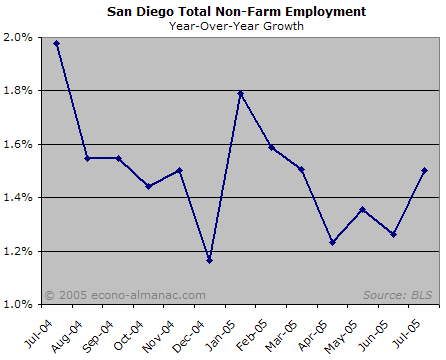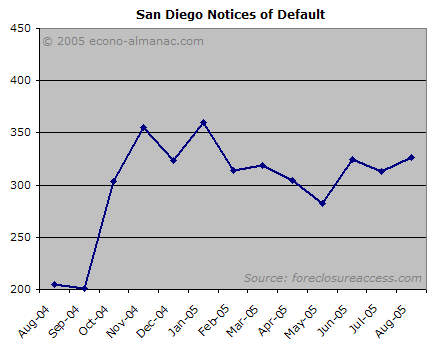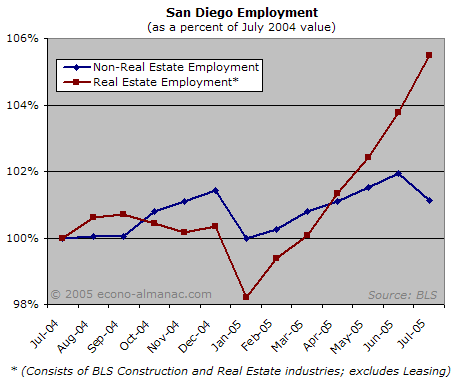The San Diego job market is booming–if you’re in construction. (Otherwise it’s pretty mediocre). Meanwhile, a nationwide recession looms, but the local economy soldiers on…
Let’s start with the good news. Job growth, while not exactly explosive, is safely in positive territory:

Meawhile, San Diego homeowners are for the most part able to service their mortgages:

The above two factors indicate that very few homeowners are currently being forced to sell.
However, trouble may loom just around the corner. The disparity in growth between real estate and non-real estate jobs keeps getting wider, with real estate jobs up 5.5% on the year compared to a meager 1.1% for non-real estate jobs:

This job growth pattern indicates that San Diego’s economy is growing ever more dependent on the real estate market even as that market has begun to slow. When real estate activities slow enough to cause job losses in the real estate and construction sectors, it will become clear just how fragile the San Diego economy is.
The most immediate threat to San Diego housing, however, may be the prospect of a nationwide recession. The nationwide economy has weakened over the past several months and now seems supported almost entirely by speculative housing booms throughout the country. As a matter of fact, economist John Williams notes that when one calculates the Consumer Price Index the way it was calculated in the 90s,* we may already have entered a recession.
So things were looking bad—and then Hurricane Katrina entered the picture. The toll Katrina has taken on people’s lives is obviously tragic and enormous, but the toll on the nationwide economy may be significant as well. The damage to rigs, refineries, and shipping corridors has driven already-high gas and energy prices to even further heights across the country. Katrina-related energy price increases, even if temporary, are estimated by Morgan Stanley’s Richard Berner to take $140 billion out of consumers’ pockets, and thus out of the already-faltering economy. Katrina’s financial and psychological effects could very well serve as a tipping point into an economic slowdown.
Conclusion
San Diegans aren’t being forced to sell yet, meaning that no downward pressure is being exerted on the market. But things look ever more dangerous for San Diego’s economy. As the imbalance between the “real estate economy” and the rest of the economy grows, a nationwide economic slowdown may already be upon us. It’s tough to know how a national recession would affect San Diego real estate, especially considering that the Fed could use the opportunity to start cutting rates again. But I promise to be as obsessive as ever in trying to answer these questions… in the meantime, please be cautious.
* During the Clinton years, significant changes were made to the methodology for calculating the CPI. The two most notable changes were the use of substitution bias and hedonic adjustments.
Substitution bias assumes that as the price of something goes up, people buy less of it. Williams’ favorite example is that if the price of beef were to go up, the BLS assumes people would start buying more hamburger and less steak. Steak would thus be given a lower weighting in the CPI calculation, whereas cheaper hamburger would be given a higher weighting, thus offsetting the rise in beef prices. Whether right or wrong, by their very nature such adjustments systematically ensure that CPI will be lower than it was when a fixed basket of goods was used.
Hedonic adjustments involve translating quality improvements into lowered cost. For example, if you bought a computer a year ago for $1000, and you buy a $1000 computer now that is twice as powerful, the BLs would calculate the hedonically adjusted price of the new computer at $500 to account for the doubling of power. Again, there may be some benefits to accounting for quality improvements, but the use of hedonic adjustments causes the CPI to be lower than it should be, allowing the post-adjustment declines in (mostly foreign) durable goods to offset the increases in the costs of food, energy, health care, and so on.
The net effect is that the CPI is always quite a bit lower than it would be if calculated using the old methodology. The June CPI, for example, would have been 5.3% using the old method, as opposed to the new method’s measurement of 2.5%. Since GDP is adjusted for inflation via (not via the CPI exactly, but via a similar measure), the GDP number using the old inflation-measurement methodology is “hardly statistically distinguishable from zero growth,” according to Williams. In other words, according to the early-90s definition we may already be in a recession.
If this kind of thing interests you, I highly recommend checking out Mr. Williams’ website.
